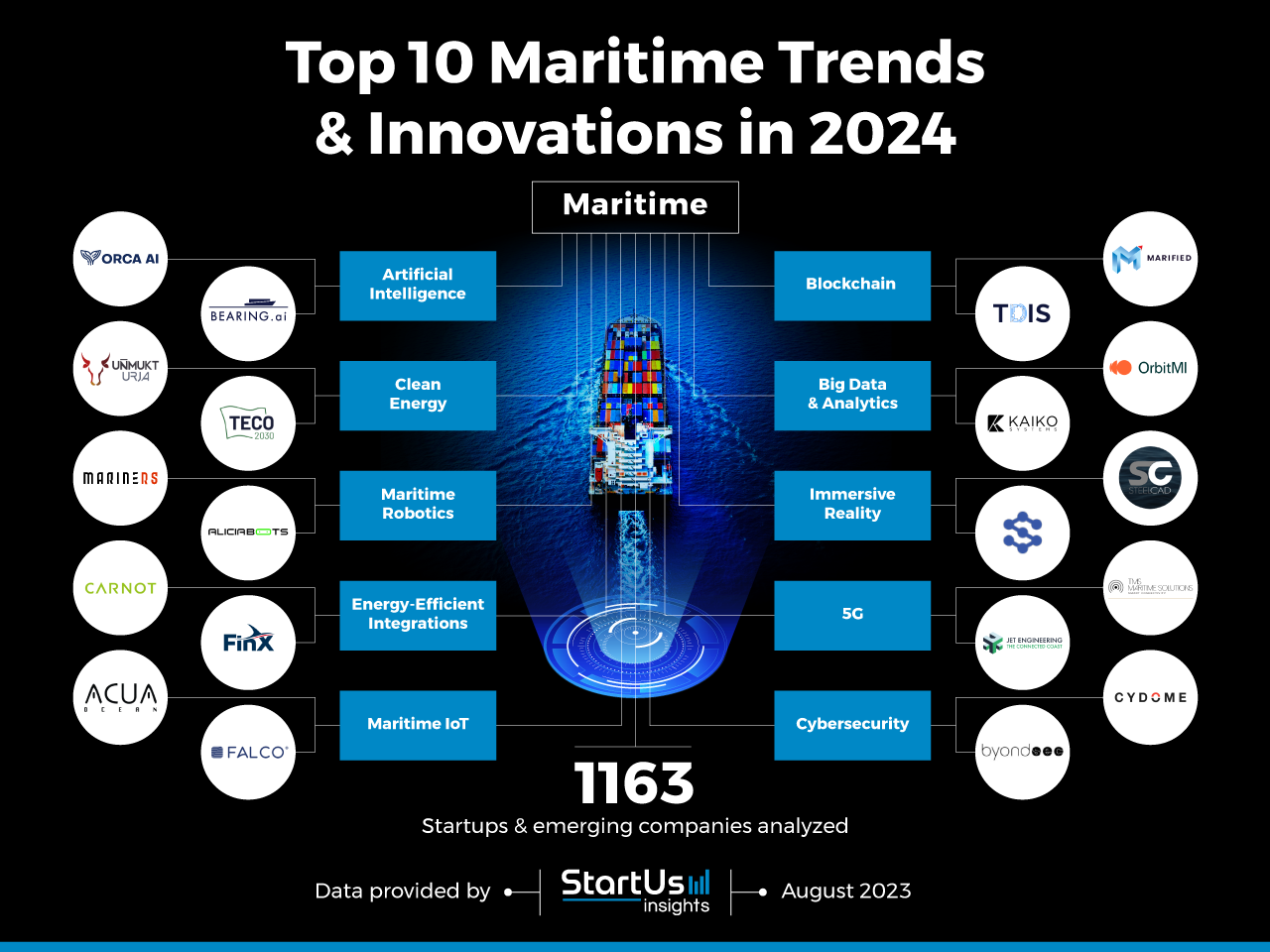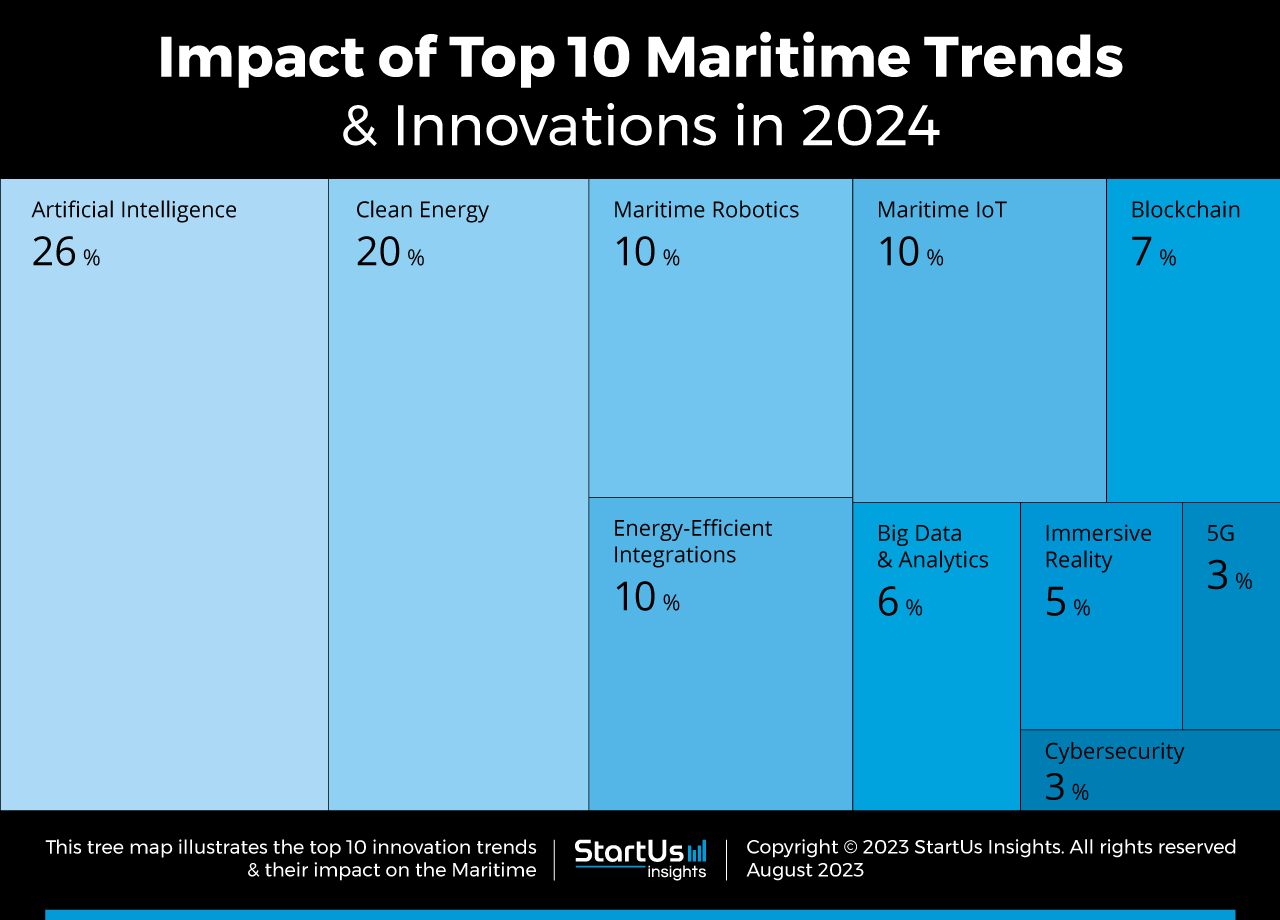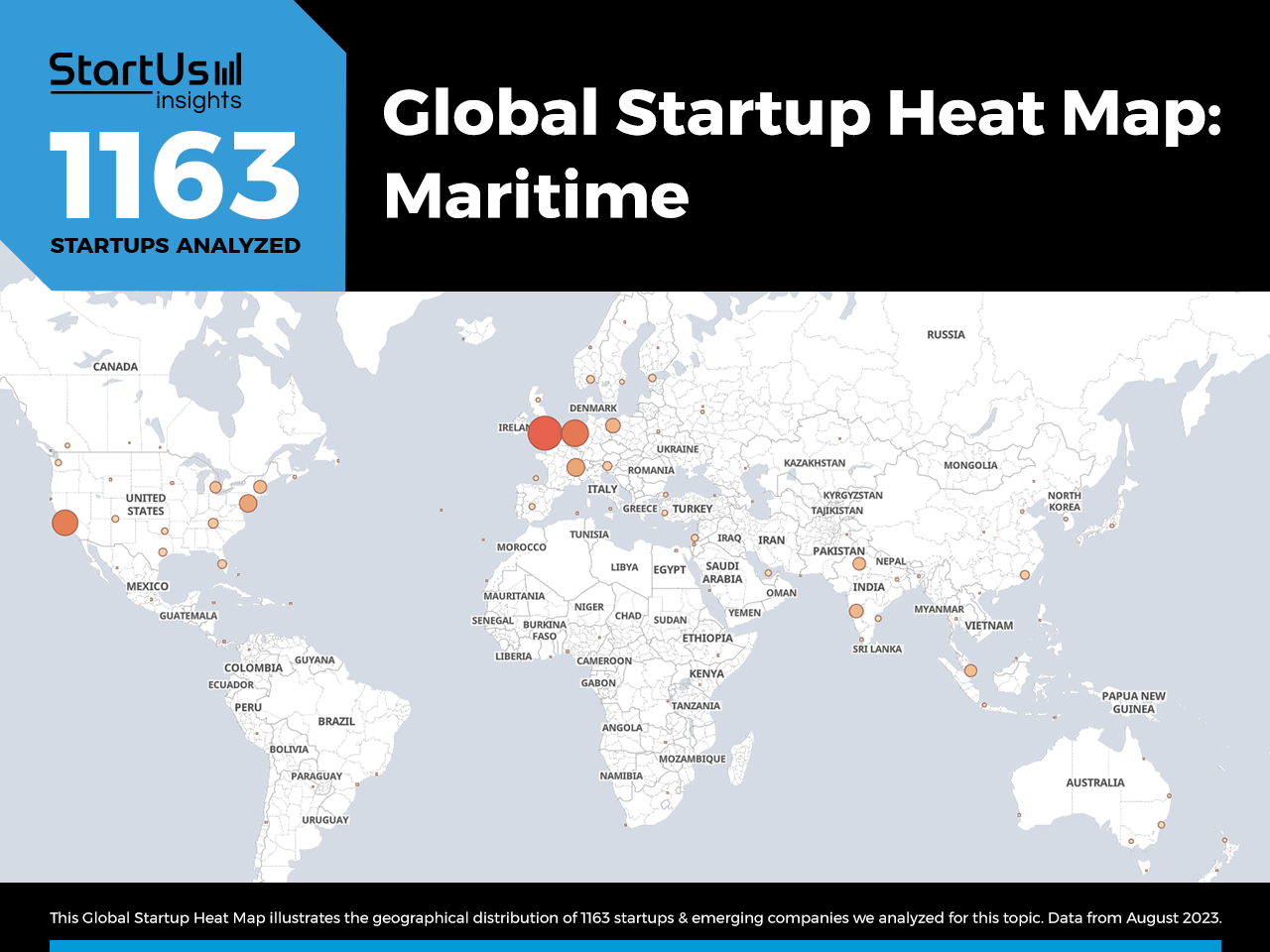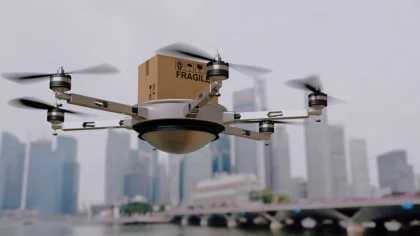Supply and demand imbalances, environmental imperatives, and a shortage of skilled workforce present significant challenges in the maritime industry. Future trends focus on mitigating these impacts through cleaner energy sources and energy-efficient integrations that reduce environmental consequences. The application of artificial intelligence (AI), big data, advanced analytics, the Internet of Things (IoT), robotics, and blockchain enhances operational efficiency across maritime segments. Immersive reality technologies, including augmented and virtual reality (AR/VR), target improvements in training, engineering, and inspection processes. These advances allow the industry to transition towards more sustainable, efficient, and resilient operations.
This article was last updated in August 2024.
Top 10 Trends in the Maritime Industry (2025)
- Artificial Intelligence
- Clean Energy
- Maritime Robotics
- Energy-Efficient Integrations
- Maritime IoT
- Blockchain
- Big Data & Analytics
- Immersive Reality
- 5G
- Cybersecurity
Innovation Map outlines the Top 10 Maritime Trends & 20 Promising Startups
For this in-depth research on the Top Maritime Industry Trends and startups, we analyzed a sample of 1163 global startups & scaleups. This data-driven research provides innovation intelligence that helps you improve strategic decision-making by giving you an overview of emerging technologies in the maritime industry. In the Maritime Industry Innovation Map below, you get a comprehensive overview of the innovation trends & startups that impact your company.
These insights are derived by working with our Big Data & Artificial Intelligence-powered StartUs Insights Discovery Platform, covering 4.7M+ startups & scaleups globally. As the world’s largest resource for data on emerging companies, the SaaS platform enables you to identify relevant technologies and industry trends quickly & exhaustively.
Want to explore all maritime innovations & trends?
Tree Map reveals the Impact of the Top Maritime Trends
The Tree Map below illustrates the top 10 maritime trends that will impact marine companies in 2025. AI is the top maritime trend due to its wide range of applications across the industry, including route and fuel optimization, autonomous navigation, and predictive maintenance. Clean energy sources and energy-efficient integration constitute a larger part of the trend due to decarbonization.
Maritime robotics compensates for the lack of workforce in the industry while IoT, blockchain, big data, and analytics enable data-driven maritime decision-making. Immersive reality further enhances training and maintenance tasks. Lastly, 5G and cybersecurity strengthen the communication network for reliable offshore connectivity.
Global Startup Heat Map covers 1163 Maritime Startups & Scaleups
The Global Startup Heat Map below highlights the global distribution of the 1163 exemplary startups & scaleups that we analyzed for this research. Created through the StartUs Insights Discovery Platform, the Heat Map reveals that Western Europe is the biggest hub for maritime technologies followed by the US.
Below, you get to meet 20 out of these 1163 promising startups & scaleups as well as the solutions they develop. These 20 maritime technology innovations are hand-picked based on criteria such as founding year, location, funding raised, and more. Depending on your specific needs, your top picks might look entirely different.
Top 10 Maritime Industry Trends in 2025
1. Artificial Intelligence
In the maritime sector, artificial intelligence finds use in predictive maintenance, autonomous navigation, and route optimization. The key role of AI is to process vast sensor data, public information systems, and asset tracking to yield actionable insights. Leveraging this information, startups enhance forecasting accuracy and optimize fuel efficiency, maintenance, and operational costs.
AI’s role extends to underwater robots and vehicles, aiding search and rescue operations and underwater repairs. Continuous monitoring of ports, ships, and fleets is made possible by AI-powered digital twins, improving vessel and port management. Furthermore, AI boosts safety by analyzing historical accident data, enabling better risk management strategies.
Orca AI develops a Collision Avoidance System
Orca AI is an Israeli startup that provides an AI-based collision avoidance system for ships. The startup combines high-resolution thermal imaging and deep learning to create an awareness system. It offers predictions and alerts on hazards to avoid collisions and, in turn, save lives. Additionally, the thermal camera ensures visibility in low-light conditions while continuous data monitoring optimizes risk assessment to improve event response. Orca AI also develops a visibility platform for fleet management to ensure safety and regulatory compliance.
Bearing provides a Smart Routing Engine
US-based startup Bearing offers a smart routing engine for maritime operations. The startup combines deep learning with various real-world data sources such as the latest weather forecasts and market rates to generate accurate ship performance models. As a result, the routing engine’s recommendations automatically adapt throughout the voyage. This allows fleet managers and vessel owners to reduce fuel consumption and improve overall fleet management.
2. Clean Energy
Maritime operations, primarily propelled by marine heavy fuel oil (HFO), contribute significantly to emissions. A shift towards low-carbon, renewable energy sources is vital for maritime decarbonization. Electric propulsion technologies, biofuels, wind energy, solar power, and hydrogen fuel are gaining traction. Startups are emerging with devices to retrofit boats for electrification.
Large marine companies are integrating low-carbon fuels into their fleets, with biofuels as an economical, low-carbon alternative that can replace HFO without structural upgrades. The trend is shifting towards electric and hydrogen propulsion, which significantly reduces emissions without compromising vessel productivity. A pivotal step in this green transition is the adoption of liquefied natural gas (LNG) as a cleaner-burning fuel option.
TECO 2030 makes Fuel Cell Systems
Norwegian startup TECO 2030 engineers fuel cell systems for heavy-duty marine applications. The startup’s modular fuel cell system enables easy scalability for megawatt-scale power generation and supports a dynamic response time. Its compact design also simplifies retrofitting the fuel cell into existing fossil-fuel-powered ships.
Additionally, the system integrates an advanced fuel conditioning system that supports operations on various H2 carriers like liquid H2, ammonia, and methanol. TECO 2030’s solution thus allows maritime companies to adopt zero-emission power sources for vessel operations.
Unnmukt Urja produces Bio-Crude
Unnmukt Urja is an Indian startup that provides bio-crude as a drop-in fuel for the maritime industry. The startup partners with Licella, an Australian company, to make use of its hydrothermal liquefaction platform, Cat-HTR. In addition, Unnmukt Urja develops a smart supply chain system to reduce the cost of agricultural waste. By combining these solutions, the startup offers an economical lignocellulosic renewable energy to replace crude oil. As a result, ship and fleet owners are able to integrate low-cost bio-crude without massive capital investments.
3. Maritime Robotics
Worker scarcity and safety in marine environments are pressing issues. Startups are addressing these by developing maritime robotics solutions, leveraging AI and advanced hardware. Robots, designed for maritime maintenance, cleaning, rescue, and inspection, are becoming prevalent. These include automated robots for underwater maintenance tasks, equipped with specialized arms and hardware systems.
Drones are also deployed at ports and ships for inspections and provision delivery. These robotic solutions not only fill the worker gap but also reduce exposure to hazardous conditions during maintenance and inspections. Additionally, these robotic systems gather vital data on ocean health, contributing to conservation efforts.
Alicia Bots develops a Multi-Purpose Robot
US-based startup Alicia Bots manufactures a multi-purpose robot for vessel cleaning and maintenance. The startup’s robot, Roverclean 1.0, functions in both remote-operated and autonomous modes to remove sludge from tanks, detect corrosion, polish propellers, and clean hulls. In addition, Roverclean 1.0 assists with repairs, inspections, and data collection. This allows vessel operators and maintenance teams to increase hull resistance and reduce biofouling, in turn, improving fuel efficiency. Since the robot also functions underwater, worker safety is not compromised either.
MarineRS builds Marine Robots
Russian startup MarineRS makes marine robots that carry unmanned aerial vehicles (UAVs) and underwater robots. Moreover, the robot contains several devices for environmental monitoring, surface and water temperature measurement, and wave height calculation, among others. Since it is a carrier, it functions both as a service platform and for hydrography and underwater archaeology purposes. The startup’s robot also enables the industry to establish a maritime internet to ensure 24×7 connectivity.
4. Energy-Efficient Integrations
Maritime companies are turning to energy-efficient integrations to curb GHG emissions and fuel costs. This involves enhancing various vessel systems, including scrubbers, rudders, lubrication, coatings, and propulsion systems. Startups are stepping in with waste heat recovery solutions and innovations in ship and exhaust design. These additions significantly boost the sustainability of maritime operations while cutting energy and fuel costs. Advanced hull designs and coatings are also being employed to reduce drag, resulting in lower fuel requirements for ships.
CARNOT provides Energy Efficient Engines
CARNOT is a British startup that creates energy-efficient engines for ships. The startup replaces metal components in conventional engines with ceramic parts that withstand high temperatures. As a result, the solution diverts the energy otherwise required to cool the engine for propulsion, increasing energy efficiency. Moreover, the startup’s engines run on hydrogen and biofuels to further move towards net zero. These opportunities allow bulk carriers, tankers, and container ships to significantly reduce fuel usage and the total cost of ownership, as well as carbon emissions.
FinX advances Nautical Propulsion
FinX is a French startup that develops bio-inspired boat engines. The startup deploys an undulating elastomer membrane to use this wave pattern to propel watercraft. However, the FinX solution utilizes low amplitude and high frequency to mitigate the effects of pitching and maximize engine power density. And since its membranes undulate like a fish fin, FinX-powered boats move in a straight line with improved hydraulic efficiency. In addition, the startup uses electric motors for its propulsion technology, further reducing its environmental impacts.
5. Maritime IoT
Continuous monitoring of ship locations is crucial in maritime operations, reducing collision risks and aiding navigation in challenging weather. IoT integration simplifies data acquisition, tracking emissions, machine conditions, propulsion data, and structural integrity. This provides maritime companies with granular visibility into processes and assets, enabling faster identification of bottlenecks and prevention of downtimes. Additionally, IoT contributes to regulatory compliance by supplying accurate data for environmental reporting.
Wattson Elements builds Connected Ports
Wattson Elements is a French startup that offers FALCO, a range of IoT solutions for ports and boats. The startup’s IoT devices enable boat location monitoring and pedestal management. The FALCO cloud platform uses this data to enable real-time boat monitoring and identification as well as berth occupancy, fire, intrusion, and theft detection. This enables port agents to develop a connected ecosystem, improving visibility into port operations and facilitating data-driven decision-making.
ACUA Ocean develops Zero-Emission Maritime Autonomous Surface Ships
UK-based startup ACUA Ocean builds hydrogen-powered unmanned surface vehicles (H-USV) that do not emit carbon. The H-USV features onboard power for commercial and environmental sensors as well as AI-based processing for data analysis and decision-making at the edge. Its modular design and 4500kg payload capacity ensure long endurance and reduced harbor-to-site times. Moreover, the USV increases offshore operations efficiencies while vastly decreasing operational costs.
Find out how 10 emerging technologies shape your industry!
6. Blockchain
Manual data logging systems are slow and prone to forgery. This fuels a lack of trust between maritime companies, vessel owners, vessel operators, and ports, hindering overall productivity. Blockchain technology counters this by offering transparent, tamper-proof data storage, ensuring data integrity and visibility into transactions and financial operations.
Startups are developing blockchain solutions like automated documentation platforms, payment systems, and maritime-specific smart contracts. This transparency in the maritime value chain ensures seamless operations with tamper-free data and communication flow.
Marified offers Seafarer e-Passports
Singaporean startup Marified provides e-passports for seafarers. The startup’s blockchain-based platform allows users to issue, store, manage, and verify documents. Since the document is stored in the blockchain, authorities are able to ensure protection against forgery. This allows ship management companies, training centers, and seafarers to increase efficiency and reduce costs involved with document processing while improving the safety of lives at sea.
Thrymr Digital Insurance Solutions (TDIS) simplifies Marine Cargo Insurance
TDIS is a German startup that provides a marine cargo insurtech platform. The blockchain-powered platform automates marine cargo insurance processes, from certificate generation and verification to policy management, accounting, and compliance screening. This accelerates insurance data exchange between maritime companies and, in turn, optimizes communication between insurers, underwriters, and brokers.
7. Big Data & Analytics
In the maritime industry, the surge of data from IoT devices and satellites is noteworthy. It enhances the volume of data ready for processing, leading to valuable insights into vessels and harbors. The raw data undergoes analysis by big data, extracting crucial information. Advanced analytics solutions then employ this data, generating actionable insights.
These insights find use in route management, weather condition monitoring, freight pattern analysis, and operational analytics. It enables maritime companies to streamline operations and pinpoint potential bottlenecks before they occur, thus minimizing downtimes and costs. Furthermore, dynamic pricing models for shipping services benefit from real-time data analysis, enhancing market responsiveness.
OrbitMI provides Maritime Intelligence
OrbitMI is a US-based startup that offers maritime intelligence and analytics for fleet operators. The startup’s AI-based analytics platform, Orbit OMI, aggregates marine data such as bunker prices, port activities, trading patterns, and fleet data for efficient predictive modeling.
Orbit OMI uses this data to provide an accurate view of fleets, predict competitor locations, and gain visibility into traffic and services at ports. In addition, it enables fleet owners to capture cargo opportunities and reduce bunker procurement costs. These functions optimize fleet performance and speed up the return on investment (ROI).
Kaiko Systems offers Vessel Health Insights
German startup Kaiko Systems provides vessel health insights for merchant ships. The startup utilizes a mobile app at the crew end to facilitate inspection activities. The checklist-based routine inspection data from the smartphone app is provided to the management team ashore in real time.
Kaiko Systems also uses this data to generate and track key performance indicators (KPIs) of vessel operations as well as automate alarms and monitor problem patterns across the fleet. The solution reduces operational costs and facilitates easy collaboration for maritime companies. Further, insurance firms use the data to optimize risks and reward loss-preventing behavior.
8. Immersive Reality
Conventional maritime education and training often do not offer hands-on experience before operators are deployed at oceans, affecting seafarer competence. Task-specific information during training or maintenance operations is provided by augmented and mixed-reality solutions. For instance, immersive simulations of tasks at vessels are enabled by VR, leading to more effective training.
Immersive technologies extend their use beyond operator training. They are employed in the remote operation of boats and submarines, maintenance, inspection, ship engineering, and design. Remotely operated vehicles (ROVs) function at extreme depths, unreachable by divers, enhancing oceanographic research. Immersive visualization of this data aids shipbuilders in optimizing ship design and accelerating part and ship manufacturing. Additionally, AR overlays digital information onto physical components during maintenance and repairs, simplifying complex tasks.
YachtingVerse creates Immersive Maritime Experiences
YachtingVerse, a Turkish startup develops a VR platform to enhance the maritime experience. The platform streamlines yacht chartering, sales, and crew recruitment, while also offering financial management support and promoting industry collaboration. It offers features including YachtPay, which eases yacht-related financial transactions, and YACHTSwap, a tool for efficient cryptocurrency trading.
The platform encompasses a range of services, including VR yacht exploration, a marketplace, yacht management tools, charter and sales options, crew management, and financial tracking. It further offers educational resources for maritime enthusiasts.
STEELCAD advances Marine Engineering
STEELCAD is a Polish startup that provides marine engineering services. The startup combines 3D laser scanning and photogrammetry to create point clouds of existing ship designs and transfers them to computer-aided design (CAD) models. This significantly speeds up product design and finalization. Along with that, STEELCAD uses AR and 3D rendering to showcase the final product in a photoreal environment. This enables vessel owners to easily track work progress and the finalized designs, improving collaboration between engineers and project owners.
9. 5G
The integration of IoT into offshore communication networks results in a high network load on the connectivity infrastructure. Real-time information becomes crucial for data-driven process planning in maritime operations to prevent disruptions. Addressing these concerns, 5G provides a network system capable of handling the high volume of IoT data with low latency. This significantly optimizes port operations and vessel traffic management.
5G not only handles data traffic but also enables remote operations, including search and rescue operations. In port operations, the efficiency of cargo handling and tracking sees a boost with 5G, leading to reduced turnaround times.
TMS Maritime Solutions facilitates Near Shore Communication
TMS Maritime Solutions is a Spanish startup that offers managed 5G connectivity solutions for near-shore communications. In addition, the startup deploys very small-aperture terminals (VSATs) for offshore communication. This, in turn, enables robust communication between vessels and ports. The startup allows ports and harbors to readily integrate 5G without excessive upfront development or capital costs.
JET Engineering System Solutions provides 5G at Sea
JET Engineering System Solutions is a British startup that enables 5G at sea. The startup deploys autonomous and uncrewed connectivity platforms to achieve this, creating a 5G mesh. This network provides a low-latency, high-speed network for vessels and other maritime assets. In addition, it improves search and rescue operations, optimizes aquaculture management, facilitates offshore renewable asset monitoring, and enables smart ports.
10. Cybersecurity
Transitioning to digital tools exposes maritime operations to cyber threats. Vulnerabilities in networks and connected devices become targets for malicious hackers. These cyber-attacks compromise sensitive information and system control, leading to reputational damage and increased legal costs.
Startups are addressing this issue by developing cybersecurity solutions tailored to marine settings. As interest in IoT, autonomous ships, and data analytics grows, these solutions ensure operational stability. Incorporating encryption and secure access controls is crucial for maintaining confidentiality in shipping operations.
CYDOME provides Fleet-Wide Cybersecurity Coverage
Israeli startup CYDOME provides fleet-wide cybersecurity coverage for the maritime industry. The startup offers a hardware device that connects with the communication network as well as software for device access and management. Once installed, the solution maps all assets, such as IoT devices, engines, and generators, to find vulnerabilities and patch them.
Besides, it applies continuous monitoring and deep analysis of several data points to mitigate cyber-attacks. The real-time detection and alerting system against unauthorized access allows fleet owners, offshore facilities, and ports to automate compliance and prevent maritime cyber piracy.
CyberOwl offers Cybersecurity for Maritime
CyberOwl provides cybersecurity solutions for the maritime industry. Its product, Medulla, delivers near-real-time visibility and monitoring of cyber risks across IT, IoT, and OT systems onboard vessels. Medulla works by identifying and inventorying assets to monitor communication patterns and detect early signs of cyber attacks, anomalous activities, and policy non-compliance. The product’s features include actionable intelligence, insider threat management, compliance automation, and asset-centric risk visualization.
Discover all Maritime Trends, Innovations & Startups
Advancements in connectivity and on-premise systems enable the integration of emerging technologies in the otherwise disconnected and remote maritime sector. Clean energy and energy-efficient integrations collectively reduce the emissions of the industry. AI, robotics, big data, analytics, and blockchain further improve the efficiency of maritime operations.
The innovative maritime solutions and trends outlined in this report only scratch the surface of trends that we identified during our data-driven innovation & startup scouting process. Identifying new opportunities & emerging technologies to implement into your business goes a long way in gaining a competitive advantage.
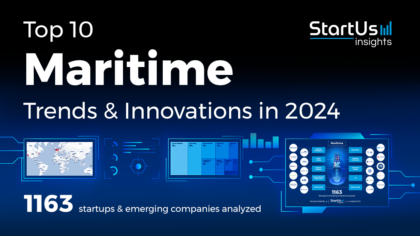
 WATCH THE VIDEO VERSION
WATCH THE VIDEO VERSION 